#also this show was the framework for a... good portion of my childhood
Explore tagged Tumblr posts
Text
My brain whenever I read the word "ger":
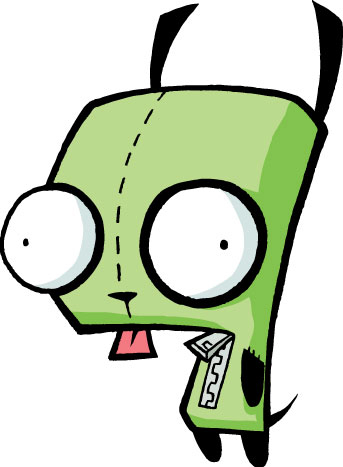
#meme#jumblr#jew by choice#jewish conversion#personal thoughts tag#gir is a jew btw. because i love him#also this show was the framework for a... good portion of my childhood#i'm not sure how ger is pronounced but i pronounce it like gir so that's why lmao#it's still insane to me that the guy who made johnny the homicidal maniac made a KIDS SHOW 😭😭😭#i follow him on twitter and he's just as weird there (affectionate)
19 notes
·
View notes
Text



𝐏𝐫𝐨𝐛𝐥𝐞𝐦𝐚𝐭𝐢𝐜 𝐒𝐮𝐦𝐦𝐞𝐫 𝐑𝐨𝐦𝐚𝐧𝐜𝐞 𝐛𝐲 𝐀𝐥𝐢 𝐇𝐚𝐳𝐞𝐥𝐰𝐨𝐨𝐝 - 𝟓.𝟕𝟓/𝟓 ☆ . ݁ ˖ˎˊ˗

“Because that’s how relationships work. If it’s a good one, you let loose. You show all sides of yourself.”

Premise: Maya Killgore is twenty-three and still in the process of figuring out her life. Conor Harkness is thirty-eight, and Maya cannot stop thinking about him. It’s such a cliché, it almost makes her heart implode: older man and younger woman; successful biotech guy and struggling grad student; brother’s best friend and the girl he never even knew existed. But not everything is as it seems—and clichés sometimes become plot twists. When Maya’s brother decides to get married in Taormina, she and Conor end up stuck together in a romantic Sicilian villa for over a week. And as the destination wedding begins to erupt out of control, she decides that a summer fling might be just what she needs—even if it’s a problematic one.
Couple: Conor Harkness and Maya Killgore
Tropes: age gap romance, brother's best friend, opposites attract, friends to lovers, vacation romance, nonlinear narrative
Content Warnings: death (off-page/in the past), grief
Review Below!
Review:
Ali Hazelwood, I sign my life over to you. You can do anything you want. This is an author that has only grown so so much stronger with each book. I thought Deep End was my favorite and it wouldn’t be a competition and this came and completely wiped the floor with Deep End. Obviously when it was announced I was so so excited to see Ali’s take on an age gap romance that it much more significant than her previous books but I could not have ever expected what she would do with that specific trope and how much it would emotionally destroy me at times. The thing that really did it for me with the way she handled the age gap was how deeply rooted it was in Conor’s character. It wasn’t just a silly thing to be used for conflict but actually had real effect on the characters, Conor most specifically, because of who they are and their histories.
Conor is I believe the most unique of the contemporary Ali Hazelwood men in just how many layers he has to him. Yes, he still fits the bill for the classic Ali Hazelwood refrigerator man who is beyond obsessed with his girl. But he’s so much more than that. When I first started the book, I was sad about the lack of dual POV that Not in Love had because it was something that worked so well for me with Eli and Rue and I had assumed it would translate over to this book. However, it’s the lack of it that really allows Conor to shine and let the reader peel away all of these interesting layers about his character.
Maya is a hoot. She is, again, within the typical Ali Hazelwood FMC framework of spunky with moments of insecurity but she also felt refreshingly different from her previous FMCs at the same time. Her anger issues and the aftereffects of her childhood, as already slightly brought in Not in Love, just really made her stand out for me. Her dynamic with Eli is one of my favorites of any “side characters” in Ali’s books but her dynamic with Conor really just makes this book shine. It feels so natural for them and really just shows how well Ali Hazelwood has done in writing two opposite characters and making them connect in such an amazing way.
This is my new favorite Ali Hazelwood book. Hands down. No competition. It may take quite a bit of force to dethrone this one. Conor may not dethrone Jack Smith Turner for favorite Ali Hazelwood man overall but he is definitely my favorite in his writing. My truly tiniest nitpick that interferes with this book being 6 stars for me is that there is a tiny portion of the beginning of the book in which I don't think the author has a good grip on Maya and Conor's dynamic but even then, I understand why the development of that understanding had to wait so it's quite a tossup for me. I will be thinking about this book for days and dreaming of my own (hopefully less-) problematic summer romance.

My Ratings:
Characters - 5 ☆ - believable, change and grow, memorable, multilayered, unforgettable protagonist
Plot - 5 ☆ - addictive, nonlinear narrative, satisfying conclusion, steady pacing
Setting - 5 ☆ - atmospheric, beautiful, historical, picturesque, vivid descriptions
Writing Style - 5 ☆ - beautifully-written, descriptive, original, witty

#⊹₊ ⋆ᯓ★ book review#book review#bookblr#review#ali hazelwood#problematic summer romance#problematic summer romance ali hazelwood
16 notes
·
View notes
Note
alicent for the character ask
How I feel about this character
i think the main core of a desperate unsaturated hunger i identify as the reason i love rhaenyra is key to alicent as well, its just a matter of being repressed, denied, turned septic. alicent too is starving for this connection and fulfillment and the course of her life makes it impossible to lay hold of and it transmutes to this seething poisonous fury. but the fury is there, the fury is important. alicent’s inability to ever completely buy into the broken bargain of the good girl and the good woman is always key. i love the more toxic forms it takes - the sheer nastiness of a sexualized desire to punish rhaenyra for her betrayal of aristocratic womanhood’s structuring contract, the need to finally make herself out of the life to whose making her life was sacrificed by crowning aegon and stripping rhaenyra of everything in a betrayal that destroys all involved - and how it is always balanced out by these constant fitful, incomplete jerks to honor another effaced life - her regret and horror at her own violence in 1.07, her taking rhaenyra’s hand in 1.08, the brutal selfishness which is also immense love in sparing rhaenyra’s life in 1.09, her entire grand disillusionment in s2. a wonderful and far more complex character than both her haters and fans seem to comprehend.
All the people I ship romantically with this character
rhaenyra. i have a deep fondness for her and daemon and contemplating both the triangulation at play in their twinned obsessions with rhaenyra and also how they could bond, on a continuum from antagonistically to productively under imagined AU scenarios, around their weird but unacknowledged similarities. i also ship alicent and all her kids - the thing of the emotionally stunted child bride and her inappropriately intense relationships with the children to whom her adolescence and young adulthood is subsumed to is a beautiful psychosexual stew, but my favorite is helaena with its sticky love that so easily can turn cloying and sour. also of course her father. and i wish her sexual awakening in s2 had been via larys sexually coercing her, not with criston.
My non-romantic OTP for this character
idk if i really have any. i guess i said alicent and viserys for viserys’ ask but something that is interesting to me about alicent is the inescapable and claustrophobic sexualization of all her relationships. sorry baby.
My unpopular opinion about this character
i guess my most recent one is her writing in s2 is good and i think people mad about her arc there are mad because they made up a character who never really existed. her entire life has never been her son, and her need to pursue redress through using him for political power in her own right is a thing that only came into being from specific circumstances (see her staunch support for rhaenyra up through 1.04) and is in complex conflict with other longings. this fixation with aegon’s cause was something forced on her she has tried to redeem and find meaning in, but it is always doing war with her desire and love for rhaenyra. that is the text of the show itself - see above. the ten years of her alienation from rhaenyra which in part flows from a belief she cannot trust her, even if alicent’s perception of that broken trust stems from a misogynistic framework of women’s political honor being bound up in sexual continence, is actually a minor portion of both her life and more importantly the show itself, as it only lasts for two episodes.
even in s1, in 1.08, she yearns after something different. her neurotic edge of breakdown/breakdown in 1.06/7 is not from the success of her repression but its failure: she is always fatally split. she tries to have it all and crown her son and attain a political existence and irrevocably compromises it instantly by sparing rhaenyra’s life because she can never, ever, actually put her children before her the love of her own lost childhood and what it signifies to her. and it dooms her children, and she realizes it when she sees aegon’s burnt body after rook’s rest and also believes he is no longer a king because he is no longer a king she can make herself through. 2.08 actually makes perfect sense if you’ve watched the show, where she now condemns aegon to try to save the child she feels she can save and crown rhaenyra and continues on her path to dooming them all because of this primal, irresolvable split between the life others ordained for her and her own selfhood.
One thing I wish would happen / had happened with this character in canon
all that said my problem with 2.08 is not its content but its pacing - i’m worried they played this hand too soon and now i am kind of baffled where they are going to go with alicent! so my answer is…i don’t know!
13 notes
·
View notes
Note
Oh Anon, it's not just you who fears much of the fandom. I'm also a cult-survivor (x-ian type too even), and that sense of hatred/lack of compassion/whatever towards Hodak's story really does feel like it would spill over to people like us should they know our stories too. And I truely hope that it's rooted in ignorance for them that the Cult is Everything. Because once we truly saw Hordak's backstory at the beginning of S5? I immediately forgave him and considered him a good person. (pt1)
Because after seeing Horde Prime? I saw all the things Hordak DIDN'T DO that had he been as power hungry and vicious as people claimed he was, he really should've done given the context of his upbringing. He didn't forbid names He didn't punish people for disagreeing with him. He actually let his subordinates /change his mind/ if their reasoning was sound He didn't forbid personal items for members of the Horde He allowed diversity in dress and uniform as long as the emblem was present (pt2)
He gave concrete rewards for competent and exemplary behavior (which Prime never did) The punishments he gave out centered on actual mistakes and backstabbing vs not meeting standards of perfection And those are just the things off the top of my head. Yes, he's angry all the time up until that point in the series. Yes, he's hurt people who are under no obligation to forgive him. But he is also the closest I have ever seen a character like myself. (pt3)
Because I too, am a chronically ill raised-in-a-cult survivor who was punished for their disability. And I think it's extremely important that people like us see characters that reflect us be forgiven. Because we never had a choice in the beginning, and we know arguably better then anyone that there's no inherent good or bad just what we're taught. That we caused harm because it was the only way we knew to do right? Not our fault, only our behavior when shown another path is judgeworthy (pt 4)
And like Hordak, we changed once we had the option to. It's a hard road, knowing we caused the harm we've done. And knowing the harm done TO us too. Because if you're like me and Hordak dear Anon, you couldn't grow and make mistakes safely in your childhood. And where love was always conditional. Be kind to yourself, especially when others aren't. They don't know how hard it is just finding out how to be a good person when given a poisoned foundation. You're stronger than you know. (pt 5/5)
And thank you cruelfeline for taking on that anons ask and series of thoughts. I haven't run across another Hordak fan who went through much the same as I and views the fandoms reaction to Hordak fans with similar caution. Sorry for submitting so much, I didn't realize I had so much to say. I just wanted to voice solidarity with Anon and support them. I hope your day goes well and thanks again.
I am forever appreciative of anons like yourselves who talk about these situations and provide insight into your own, personal reasons for connecting to Hordak, or other characters like him. I imagine that it’s a hard thing to do, especially when certain portions of the fandom are so vile. Thank you for speaking your piece!
One thing that strikes me, after reading your words, is how unfair it seems to judge someone like Hordak using a “normal” moral framework. How unfair it is to assume to everyone has the same moral foundation, the same understanding of the world, and thus should be aware of what is and isn’t good behavior.
Something that I’ve always found heartbreaking about Hordak is that, given his foundational upbringing, I fully believe that he thought that what he was doing was good behavior. I believe that he was trying his best to be a Good Boy, doing what he understood to be appropriate in order to be thought of as a good person in the eyes of his god. It’s not his fault that he was taught wrong. And it’s cruel to demand that he, with no help whatsoever, adopt a whole new moral framework out of no where. How, exactly, is he supposed to do that? How is he supposed to come to the realization that his god is wrong, without someone to show him the way?
Thank you again, anon, for your words.
58 notes
·
View notes
Text
Devil May Cry: Series Retrospective- "DmC: Devil May Cry"
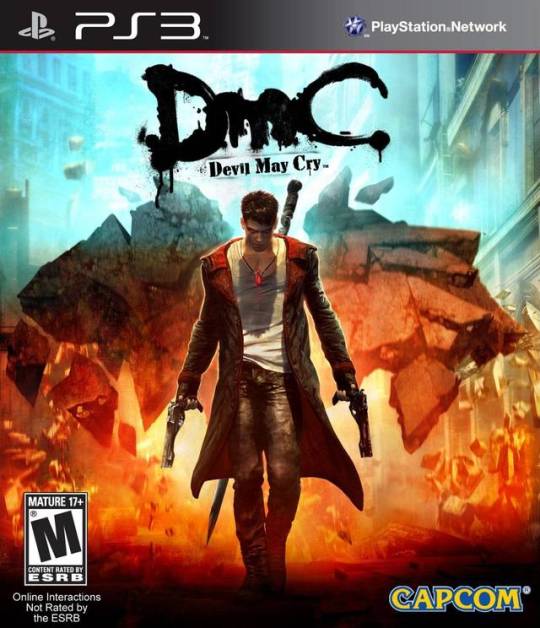
At long last, I sat down and played DmC: Devil May Cry. Well and truly, the dust has settled, the dead horse has been beaten into compost, and the reactionary rages and defenses have died down. And, for myself, I think my fanboy passion for the series has subsided.
A weak Special Edition, a pachinko machine and a bad MvC model later, I hold out no honest hope for the Devil May Cry franchise now. We’ll always have the Temen-ni-Gru Dante...but we’re not getting back together, lets face it.
So now, when I look at Ninja Theory’s protagonist, who I will still refer to as Donte, the fresh insult that he used to be is now replaced with a genuine, tryhard, grittiness that just seems cute in an “ah, bless” kind of way. He’s no longer the sour white whale that ate my favourite character and franchise, he’s just a little fish who flops around in a harmlessly funny way.
....before the massive flaws of the game come forth.
This review is based on the PS3 launch version and does its best to criticize it on its own merits/failings, not merely on fan insult or in comparison to the previous games. But it is after all called “Devil may Cry”, so its existence as part of a wider franchise isn’t ignored either.
Also, fair warning, this is going to be long as hell. Which is suitable, because it feels like hell sometimes...

Technical Qualities
The engine/optimization is dogshit.
Ninja Theory infamously rejected Capcom’s offer to translate their wunderengine, MT Framework, into English so that they could use it. Instead the team built DmC: Devil May Cry using Unreal Engine 3, which was already starting to look dated by 2010 when the game was announced. For perspective, Unreal Engine 4 was revealed to the public before DmC even came out. The likely reason Ninja Theory chose to stick with Unreal was because of a developer kit popular with young game creators. Unreal 3 was a ubiquitous engine in the last gen of consoles, being the backbone of games like Bioshock: Infinite and the Batman: Arkham series. But you’ll be hard pressed to find any games using it that were as fast paced as the Devil May Cry series.
Off the top of my head, games that use Unreal 3 usually have collision and texture pop-in problems. This is less of an issue in first person or isometric games when player movement and camera angles/viewable space are restrained, but it’s disastrous for something like DmC with its wide angle camera, large open areas, dense enemy count and fast player movement.
On the very first mission, in no more than 2 minutes of having control, Donte got stuck in a wall as I tried to go through the level like a normal player. This was followed by hideous amount of texture pop-in, audio glitches that muted parts of the soundscape, a couple of attacks that didn’t connect with enemies when they should have, and loading times out the arse.
A nasty little secret I only found out from replaying it first hand was that many of the mini-cutscenes (like when Donte looks at the Hunter demon hop around buildings, or does a backflip as he collects his guns) are secretly loading screens, unskippable until the loading operation is completed. All of which are frustrating to have to sit through in such a fast paced game. The way they make such a deal out of the same, generic enemy spawning in by giving it a dramatic close-up every time feels patronizing on repeat fights. “OOOH look! It’s a flying thing again!”. Yeah, no game, these things are easy to kill and I know you’re covering up something with this. Nice try.
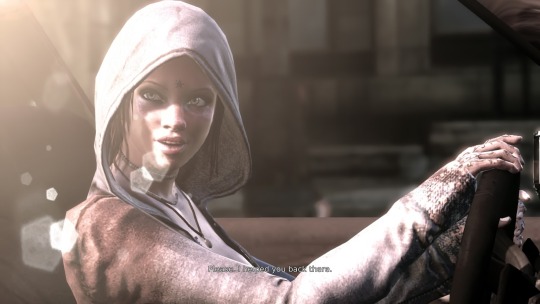
Without seeing the development build firsthand, I can’t say for certain why it ran so badly. The release of the Definitive Edition for PS4/XBONE implies that it was a hardware limitation...but....like....that’s what optimization is for; making games run well on older hardware. More on this later, but design choices in level layouts, for instance, can remedy this. You can, for instance, segment levels in a way that stops you from seeing large areas at a single moment, reducing how much the consoles needs to render and thus cutting down load times.
Instead, what we largely got were huge foggy rooms and camera lens flares there to hide unloaded textures. The problem then is that it just, in my opinion at least, doesn’t look very good. Think of how Silent Hill 2 and 3 manage to still look so good due to how they segment rooms with doors you can’t see beyond. Or how the use of fog doesn’t cover up anything that you’re supposed to be looking at. And how they manage to have shorter loading times for it, a whole generation of consoles in the past.
Another trick is to “hard bake” lighting effects into the level’s textures themselves, rather than relying on extra shader operations. It’s more taxing on hardware to emulate, say, the actual light physics of a red spotlight instead of just making the textures of the walls and floor red, using trickery to make it seem like there’s a functioning red light there. Open world games generally don’t have this option, but with Devil May Cry, which is a linear series with rarely changing environments, you can use trickery like this effectively. Instead, DmC has more shaders -many of which look terrible in cutscenes- than it can handle.
Ninja Theory did a bad job of optimizing their game for their primary hardware. Even with the update there were visual problems, audio glitches and collision bugs throughout the entire game. It’s far from unplayable, but it’s ropey for a AAA game.
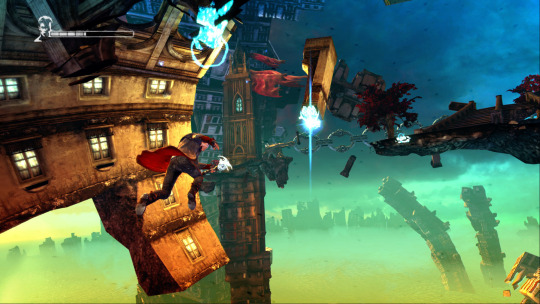
Level Design
Before I get into the artistic choices, I want to take a moment to look at the more technical, grounded aspects of how Ninja Theory designed levels.
Most of the previous Devil May Cry games are economic with their level design, reusing areas multiple times over with remixed enemy layouts and the occasional change in lighting, music and even textures. This cuts down on development time, saves disc space, and allows the designers to really put care into each individual location. Resident Evil, the Souls games, and Deus Ex: Human Revolution are other good examples.
DmC had potential for this with its “living city” concept. The best use of this concept is with Mission 2: Home Truths, where Donte visits his and Vurgil’s gigantic childhood home. As you backtrack into familiar hallways and foyers, the corruption of Mundus’ influence causes walls to crack open, pathways to change shape and different enemies to spawn. It’s a great (re)use of assets that trip up your expectations as a player the first time around. It also uses some Metroidvania style locked doors and obstacles which you need certain abilities/weapons to traverse. The unfortunate limitation of that is that you can literally fly through some levels and skip entire sections of the game upon a replay; Mission 3 requires you to unlock the Air Dash move in order to clear a gap that appears early on, but you’ll already have it on a replay, turning a 20~ minute level into a 3~ minute one.
Sequence breaking like this doesn’t happen in any huge way though, due to how each level is an entirely separate area of its own. Likewise, most of these ability/weapon barriers lead to optional bonus areas that are slightly off the beaten path.
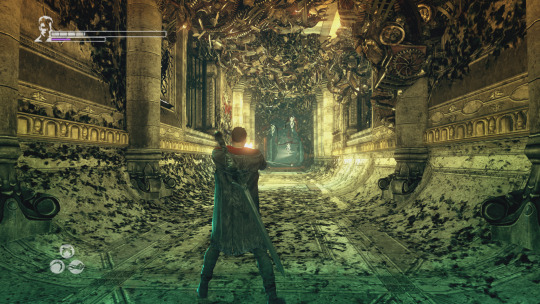
Linear level design isn’t inherently bad, but in this case I think it was a huge missed opportunity. Not only is there a parallel real world vs Limbo premise that has Donte shift from a greyscale, mundane city into a colourful, chaotic image of itself, that Limbo dimension has the ability to change in real time. If the level designers allowed players to shift from dimension to dimension in-game, a la Soul Reaver, or if they had just played up the “living city” concept in a more interactive way, the city would have been much more interesting and, ironically, feel much more alive than it does. Instead we got a linear, albeit pretty, collection of corridors with very little off the beaten path. DmC incentivizes exploration by hiding collectables, but “exploration” ultimately means turning left where you should turn right to find a Lost Soul behind a bin.
One place where they ALMOST got it right is the first Slurm Virility factory level. After a cutscene showing a mixing room, Donte and Kat break from the tour, slowly jog down some empty, boring hallways in to an equally empty and boring warehouse. Dante can’t attack or jump in this section, and there is absolutely nothing to interact with. It’s an unfortunately uninteresting forced walking section, only one small step above being an unskippable cutscene. Kat then sprays her squirrel jizz magic circle on the ground, Donte enters the Limbo version of the level, the room expands and the crates become platforms, and the level really begins from there. For reasons I never understood, Donte then has to take a huge route up sets of boxes and across dozens of different rooms to circle back on the way he came in. On the way back, he backtracks down the Limbo version of the boring hallways of before, except now they’re slightly less boring, with a few enemies to fight and moving walls and floors. Then you get to the mixing room (which is only shown in a cutscene) for a brawl, before moving on.
The reason this didn’t work as well as it could have are twofold. 1: You only see the real world version of a tiny portion of the level, and 2: said portion is boring as fuck and you don’t interact with it in any meaningful way. But hey, at least the idea was there.

Moments where the living city concept is pushed to the side for more one-off but more effectively done ideas can be found in the upside-down prison, the short prelude to the Bob Barbas fight and Lilith’s rave.
The upside-down prison starts off fairly strong, tapping into one of those childhood ideas we all idly wondered about; what if gravity suddenly shifted? The level starts off strong and has moments throughout that give a trippy sense of vertigo. Mostly this is with car and train bridges, but unfortunately loses the point as it progresses. Because the prison isn’t just upside-down, but is also in Limbo, gravity is already unreliable and the bottomless pit below the floor already looks like the sky. Similarly with the lead up to the boss fight with Poison that has you run “down” a vertical pipe, it all looks floaty and weird by default, making further attempts to be floaty and weird just seem...normal. Likewise, the prison is mostly comprised of bland, urban and industrial textures, completely interchangeable with any old warehouse. You quickly forget that you’re upside-down at all.
The setting also well outstays it’s welcome, taking up 4 entire levels to itself with not enough ideas to justify it. There’s even one moment where, after meeting Fineas, you’re told you need to follow a flock of harpies to find their lair....even though their lair is a completely linear set of halls...That says it all really; there was a fun idea in here, but it was executed without the same creativity.

Following that is the tragically short Bob Barbas prelude. THIS is one of the single most interesting concepts in level design I have ever seen. Seriously. I cannot think of any other game that took news graphics and idents and turned them into platforming sections. Even moments during the fight where Donte is dropped into news chopper footage manage to do something brilliantly original, stylish and funny. But as quickly as it came, it’s gone before you know it. It’s a fucking crime that the previous 4 levels didn’t use the same concept to break up the monotony of their urban corridors. They could have had Donte teleport around chunks of the level using the various TV screens with Bob Barbas propaganda on them, hopping across idents until he got to the other side. Shame.
Next up, almost in a moment of clarity from the designers when they realized that could do digital environments and cheesy tv show graphics in their game more than once, we have Lilith’s nightclub. Again, much more interesting than the living city stuff, albeit a bit harsh on the eyes with its lighting effects. There’s not much to say about it beyond “it looks cool”, but it’s worth mentioning that it feels much more focused and fully utilized than the upside-down prison. All in all. the level design in DmC is at odds with itself, marked by its lost potential. The concepts are interesting, but the execution is almost always lackluster, favouring hand-holdy linear hallways with “cinematic” qualities over more interactive, open spaces with a sense of place. For a game that, pre-release, seemed to want to show us a more fleshed out world than previous games, it winds up as little more than a flat backdrop.
But oh well, DMC is all about the action happening center stage, right?
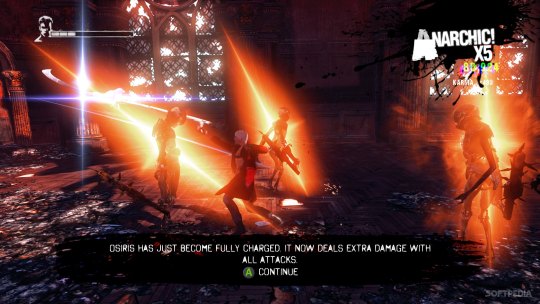
Combat
Combat in DmC is a mix bag.
The number of different attacks available and Donte’s versatility at chaining moves across 5 different weapons is pretty great. I’m a fan of how you can swap special pause combos across your alternate weapons; two quick hits with Rebellion, a pause, then a final triple smash with Arbiter takes a little extra skill to pull off but rewards you with a faster combo than if you just used Arbiter alone. Likewise, little tweaks like how fast Drive can charge now and how it does actual damage unlike Quick Drive in DMC4, or how you can hold Million Stab for longer, are all mostly fun changes. I tend to have a lot of fun with Osiris and find it to be the most versatile weapon for pulling off different combos. Its ability to charge up the more hits it delivers is a good incentive to hook in as many enemies as possible too, even if it means its uncharged state doesn’t do enough damage. Aquila is a fun supplementary weapon, mostly good for distracting one enemy with the circle attack and pulling the rest into range for Osiris. Eryx, however, is rubbish. Its incredibly short range, long charge times and weak damage output really throw it onto the trash pile when Arbiter is right beside it. Also, personal taste, but it just looks stupid. It’s like a slimy set of Hulk Hands. And they don’t even yell “HULK SMASH” when you attack. Previous DMC gauntlets all include a gap-closing dive attack to put you in enemy range, but the Demon Grapple doesn’t work the large enemies you’ll want to use it against. More on that in a bit.
Guns are mostly pointless. Donte can move laterally so much easier than before that long range combat is redundant. Charge shots with Ebony & Ivory are like Eryx in that they take too long to charge and don’t do enough damage to be worth the wait. Also, because you need to be in a neutral, non-demon non-angel, state to fire them, charging them up while you wail on someone only works if you limit yourself to Rebellion. Switching to Demon or Angel weapons resets the charge and limits you to a grapple move.
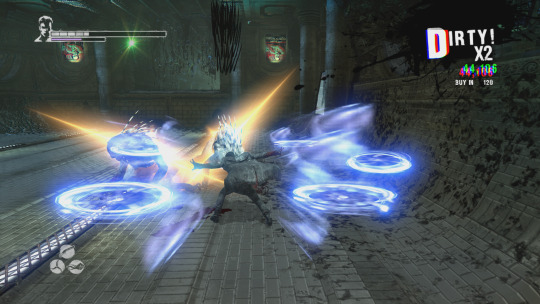
Which leads to another problem; 4 of your 5 weapons disable the use of guns. I mean, you’re not missing out on much by the end anyway because the guns are boring and ineffectual to use against all but one enemy (the Harpy), but it feels like a mistake. They literally give you guns in cutscenes as an afterthought. Like when Vurgil goes “oh yeah, have this, it’ll kill the next few enemies really quickly then sit in your back pocket for all eternity thereafter”. Donte never feels like he’s earning these guns like he earns the melee weapons, and they never seem to be worth a damn in gameplay.
The grapples are more useful but, again, having two different types feels redundant in combat. Large enemies can’t be pulled towards you, so why not do what DMC4 did and have one grapple that does both jobs; pull small enemies towards you, pull yourself towards larger enemies? The end result in either scenario is to get in melee range, so it shouldn’t make that much of a difference. Considering Aquila has a special attack to pull enemies in, why not offload those moves to the other weapons too? If you want to keep both pull-in and pull-towards moves in combat, why not give, say, Eryx a special pull-in attack so you can swap back to guns easier?
In short; while the combat is versatile and very satisfying to pull off combos with, large parts of it feel badly thought out. The moves and weapons that end up being useless most of the time have enemies spawn after you unlock them, just as an excuse to show how they work.

The infamous “demon attacks for red enemies, angel attacks for blue enemies” gimmick actually wasn’t as bad as I expected. Until I had to fight a Blood Rage and a Ghost Rage at the same fucking time. I don’t think I need to get into it due to how many other people have complained, but it was just fucking infuriating to say the least.
Okay, so.....Devil May Cry 3 did it better. Most people don’t seem to know this, but DMC3 gave you damage bonuses if you used the right weapon against the right enemies, signified by a subtle particle effect. Nowhere in the enemy or weapon descriptions does it explain this, but if you use your head (or just experiment) you can generally figure it out. Beowulf is a light weapon, Doppelganger is a shadow monster, using light on it does extra elemental damage signified by a flash effect with each hit. Cerberus is an ice weapon, Abysses are liquidy enemies, so using ice on it freezes them, signified by an icicle effect. etc But most importantly; it never STOPS you from using the “wrong” weapon against enemies. I don’t think I need to go into how annoying it is when your combat flow is interrupted by your angel weapon PINGing off a red enemy, but god damn it.
Credit where credit is due; Ninja Theory did emphasize the right part of DMC’s combat when they opted to focus on combos over balance. Both 3 and 4 had broken combos and attacks that skilled players could easily pull off, but they would make combat boring and the games all emphasized an honour system to prevent abuse. If you were good enough to use Pandora to break enemy shields in 4, you were good enough to not abuse it.
Then again, a games combat is only as good as its enemies.

Enemies/Bosses
So it’s a real shame then that enemies and bosses don’t push you hard enough.
The AI is atrocious. NO hack n’ slash should have two hardcore enemies accidentally kill each other without you noticing. The mixing room in the Slurm levels pits you against two Tyrants/the big fat dudes who charge at you. There’s an easy-to-avoid pitfall in the middle of this room. Once, on hard mode no less, they spawned in as usual and one accidentally nudged the other into the pit, insta-killing him while I literally stood still and watched...
Most regular man-sized enemies (Stygians, Death Knights, and their variations) have a common problem of just not attacking first, opting to side step around you forever until you run at them. Luckily there usually is one aggressive enemy mixed in there, like the flying guys with guns or the screamy-chainsaw men, so you’ll be forced to dodge into their range, but it’s embarrassing when they’re isolated. You’re left standing there, charging a finishing attack with Eryx like you have your dick in your hand, and these things are just strafing around you, doing nothing. So you miss with Eryx, step forward, and anti-climatically twat them about with Rebellion just to get it over with.
At first I thought this combat shyness was a design choice, but then it happened with the final boss, revealing it to be a pathfinding bug. But more on that later...
So yes, the red/blue enemy gimmick is bullshit and breaks the flow of a room-sweeping combo you have going, but it actually works really well with the Witch enemy who hangs back, projecting shields onto other enemies while she snipes at you from a distance. She’s annoying to hunt down when you’re dealing with 10 other enemies, so you have to prioritize whether you want to plough through them first or clumsily chase her down first. It’s a nice dynamic to fights, adding that extra layer of strategy to mix things up in a less punishing way.
The main difference with the Witch and the other colour coded enemies is that the Witch gives you options. Blood/Ghost Rages do not, and make fights involving them feel like complete chores. You’ll find the one tactic that works, then rely on it every time.
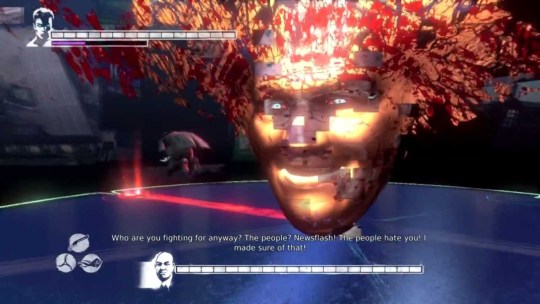
No, the most egregious enemies were the bosses.
All of them, every single one, was terrible. Not including the Dream Runner mini-bosses, there was a total of 6, less than any of the other DMCs, which makes how sloppily designed they were all the more horrendous. Every single boss is formulaic, partitioned out into “segments” cut up by mini cutscenes that have Donte do something sassy when he works them down enough. But each of those segments tend to have Donte repeat the same, boring, tired tactic until the fight is over. Bob Barbas is the worst example; jump over his beams, use that one Eryx attack to slam into the nonsensical floor buttons, wail on him for a third of his health bar, kill 10 minor enemies in his news world, repeat two more times.
No matter what difficulty you’re on, these bosses never manage to be a challenge due to how placid they are. They will always accommodate their little “formula” you need to solve to beat them.
It’s baffling, because the previously mentioned Dream Runner mini-bosses are great. They’re aggressive, reactive, open to almost any combo you can outwit them with, and don’t force you to repeat the same set of steps in every encounter.
Vurgil on the other hand....
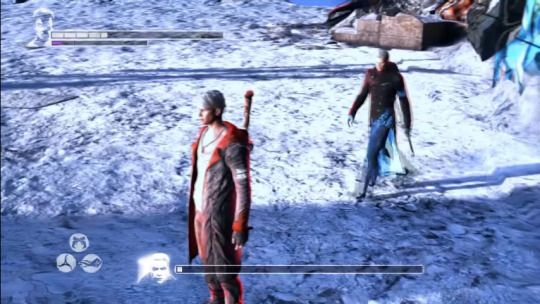
So, here we are, the grand finale. The ultimate evil has revealed itself, and it’s your own brother! You’re clearly a badass because you just took down Satan himself along with his army, so surely the only thing left that could challenge you is your more experienced twin.
Well, he would, if his AI didn’t start the show by consistently suffering from that same pathfinding bug that makes minor enemies interminably strafe around you. So far so good for my first playthrough. So I attack him, maybe hit him 5 times before a min-cutscene rears its head because I’ve suddenly made it into the next stage. Same thing happens once or twice. Then, somehow, Vurgil’s model freezes in the air during one of his attacks. He hangs there indefinitely until I attack him again. Then, at the end of the fight where he’s summoned a clone (because he can do that apparently, not that he’s ever so much as referenced the fact) so his real self can take a knee and heal, I’m supposed to use Devil Trigger to move him out of the way and finish the job (though, I don’t understand why the real Vurgil isn’t also thrown into the air). I do so, but the clone lingers on the ground for a moment, trying to attack me before just zipping into the sky; another bug. I attack the real Vurgil, but nothing happens at first. I keep wailing on him, hoping that one of my attacks will eventually collide and then, -Scene Missing-, the final cutscene of the battle plays.
Do I need to say any more? Do you see what a fucking mess the boss fights are? The final battle for humanity, the emotional crux of the story, the update to the final unsurpassed boss fight of DMC3, reduced to a buggy, embarrassing slap fight that gave me four glitches on my first playthrough.
The whole thing bungled the climax of its story. But, then again, was the story really that sacred to begin with....
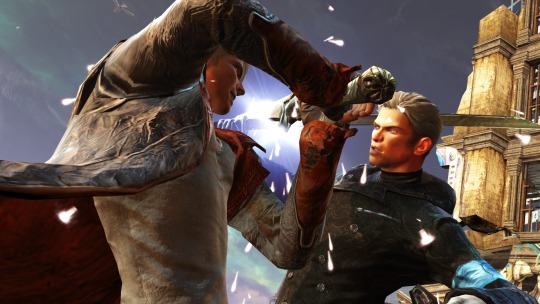
Concept and Story
I promise I will not use the word “edgy” here.
Satire and social commentary, no matter how cartoonish, is a weird fit in a Devil May Cry game. DMC2 had an evil businessman too, and 4 ended with you punching the Pope in the face, but neither seemed to say anything substantial against capitalism or religion. They existed in a much more fantastical place, where any sort of commentary was aimed at a more philosophical target. “What makes us human? What makes us into demons? What is hell like? Is family more important than what you feel is right?” The previous games are all centered around a much more personal, individualistic identity crisis, and not any sort of populist, society-wide problems.
DmC brings up surveillance states, the most recent economic crisis and late-capitalism, soft drink addiction/declining nutrition, news manipulation, the prison industrial complex, conspiracy culture, populous revolt, some scant mentions of mental institutions, hacktivism, and the Occupy Movement. These topics, all of which are pretty damn serious and warrant long discussions, are simply decoration for a story about fantasy demons secretly running the world They Live style. Hell, it basically IS They Live, only the aliens are demons and the tools of control are more contemporary. (somehow there’s nothing about the internet in there though...)
All in all, its treatment of modern issues is childishly simple at best and cynical at worst. Sure, the game presents itself as defying capitalism and social engineering via advertising, but it then goes on to launch an ad and hype campaign bigger than any of the previous games, spanning across billboards, phone apps, social media promotion, the usual games media rounds and expensive pre-rendered television commercials. Hell, they even had an ad for their ad! All of this amid a gigantic fan backlash and in-fighting with games journalists on whether people were mad about Donte’s hair colour of if they were just outrightly entitled.
The fact that lead designer and writer Tameem Antoniades responded to this backlash and feedback by tweeking Donte’s design and adding in a random moment were a wig literally drops out of the sky onto Donte’s head for a jab at this “controversy” says something about the intent he had with his story; There is no real political statement behind DmC, it simply pulls from what was in the news at the time, and uses it as fodder for an otherwise archetypal plot.

The problem is that it tries to do this while also talking about hellish demons, heavenly angels and earthly humans. Well, mostly demons, because the angels are absent from the plot and Donte doesn’t seem to have any sort of Angel Trigger, and the only named human character is Kat, who doesn’t have much ploy within the story; she’s there to be rescued, and provide minimal help with a pat on the back from Donte. So demons rule the world, the angels are absent, and the people who suffer are us lowly humans. But it’s a half-demon, half-angel who “saves” us all/reduces the city to rubble, while all us humans can do is post about it on Twitter. Doesn’t sound very empowering to me.
The main villain should say it all. He’s some sort of businessman/oligarch/banker/economist/military commander/mayor/Satan, but he makes the undeniable point that he gave human civilization it’s structure. He has a wife he at least somewhat cares about, and a child he has high hopes for. He (and his wife) shows more emotion than any of our protagonists, and they have more at stake than anyone else, with a genuine vision for the future no less. So, when he very reasonably asks Donte what his goal is, all Donte can say is “freedom” and “revenge”, then continue to childishly taunt him when pressed further. I could go on about how unhealthy the obsession with the post-apocalypse our generation has is, but suffice to say; Donte is not someone to look up to.
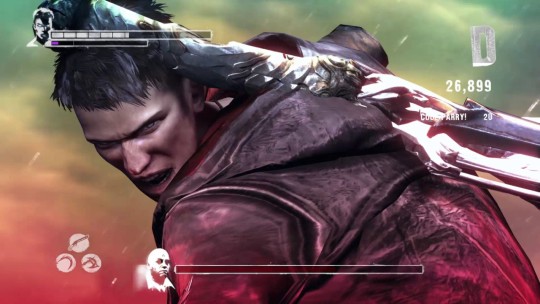
Donte himself, and by extent his story, has no real ideological motivation behind him despite being dressed up as an anarchist. His motivations and arch as a character are no less two dimensional than the original Dante, but now manage to be over-stated and hamfisted, with an added veneer of “politics”. Vurgil points how much he’s supposedly changed right before the final boss fight, but how he changes doesn’t include a strong statement of intent. What does Donte want? Fucked if I know! Fucked if he knows.
All of this says nothing about how...well....plain bad the writing is. The dialogue is famously cringeworthy and the plot has more holes than a sponge.
If Mundus was hunting Donte to kill him this whole time, why can’t he find him despite having multiple cameras aimed directly at this house? Why didn’t he just kill him when Donte was in the orphanage run by “demon scum”? Where was Vurgil this whole time? Why does Kat need to hit the Hunter with a molotov? Actually, what the fuck is she doing in the real world while this is happening? Are people just ignoring this pixie girl throwing bottles around a pier? What’s that weird dimension Donte goes into to unlock new powers? If it’s his own head, why are Mundus’ demons in it? And why would it change his weapons? Why doesn’t he have an Angel Trigger? If Vurgil can do all that cool shit he does in his boss fight at the end, including opening a fucking portal to another dimension, why does he need to rely on Kat to hop dimensions earlier on? Or rely on anyone for that matter? Why does he have white hair when he’s born, but Donte has black hair until the end? If Mundus is immortal, why does he need an heir? Why does time randomly slow down after Vurgil shoots Lilith? How did Kat know the layout of so many floors in Mundus’ tower? Surely he didn’t give her a tour of the whole building, right? Did Donte and Vurgil fuck the entire planet by releasing demons into earth and destroying world economics and governments? Or are there pre-existing governments anyway?
Seriously, I could go on forever.
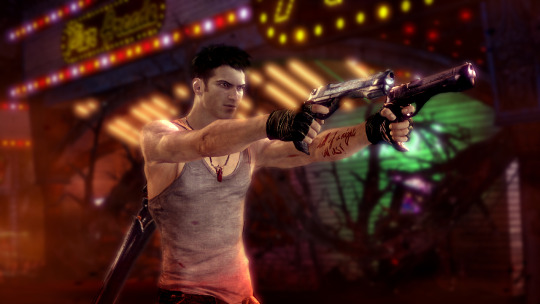
Beyond basic plot, logic and diegetic continuity (the rules of DmC’s world, and how it suspends your disbelief), you get into more subjective questions like “is Donte a likable character?”
I, perhaps surprisingly, think he is. He’s such a tryhard asshole for the majority of his game, never stopping to think about what he’s doing or to engage with the They Live world he lives in that he is, honestly, a bit adorable. He’s not someone I’d ever have the patience to hang out with in real life, but he is at least consistent. He’s a total lughead and he almost blows up the planet, but it makes sense that a nihilistic, “act first, think later” bro would do that.
And I think that sums up his story too; dumber than it thinks, but entertaining all the same. It’s a different kind of dumb than the original games, a kind of dumb that stares at the camera wall-eyed instead of with a sideways wink.

Conclusion
As of writing, I consider Devil May Cry to be dead as a series. With no solid news from Capcom on further projects for 7 years now, DmC: Devil may Cry is the swansong of the entire franchise. Well, beyond shitty cameo costumes in Dead Rising 4, or pachinko machines or whatever.
Likewise, more recent hack n slash series like Bayonetta, Metal Gear Rising and Nier: Automata have risen to challenge Devil May Cry for its crown, and without something better than Ninja Theory’s efforts to stop them, they’ll probably get it.
DmC is not a complete trainwreck. It’s enjoyable, worth the second hand price and 10+ hours of your time. It’s entertaining in a similar way a bad film is; so long as you don’t expect too much from it, you’ll have a laugh. Let go of your bitterness with Ninja Theory and Tameem and you’ll poke fun at it in a less mean-spirited way then your fan rage wants you to. DMC deserved to end on a better note than this, but.....honestly....fuck it. Capcom probably couldn’t make anything much better themselves these days anyway.
Treat DmC like a pug; malformed and lumpy, probably should have been neutered a generation ago, but funny to look at and play with, even though it’s covered in its own slobber.
15 notes
·
View notes
Link
Is the world becoming a better place? Are human beings, on average, becoming healthier, richer, safer? And if they’re not, why not? And how can we do better?
Each year, the Bill and Melinda Gates Foundation releases its annual Goalkeepers Report. The publication is thick with charts and graphs, metrics and statistics. And usually, it’s optimistic — global poverty, infant mortality, and a host of other key measures have dashed toward decency in recent years, and the Gateses have sought to make sure the public knows that progress is being made.
The 2018 edition, however, started on a tougher note. “Optimism requires being candid about the hard problems that still need to be solved,” the Gateses write. “That’s what this year’s Goalkeepers Data Report aims to do: confront a pressing yet neglected challenge, and identify some of the most promising strategies to meet it.”
“To put it bluntly,” they continue, “decades of stunning progress in the fight against poverty and disease may be on the verge of stalling. This is because the poorest parts of the world are growing faster than everywhere else; more babies are being born in the places where it’s hardest to lead a healthy and productive life.”
The Gateses are talking specifically here about Africa. “Africa as a whole is projected to nearly double in size by 2050, which means that even if the percentage of poor people on the continent is cut in half, the number of poor people stays the same,” they write.
There is no topic in the philanthropic world more fraught than population growth. The history of efforts to analyze and address it is filled with bad predictions and, worse, cruel solutions. As development expert Alex Ezeh writes elsewhere in the report, “population issues are so difficult to talk about that the development community has been ignoring them for years.”
The Gateses, though, are trying to take a different approach to the issue. Rather than seeing a population problem in the demographic projections, they’re framing it as a poverty problem — and, for that matter, an opportunity.
“There’s been a lot of discussion about what happens if large numbers of young people in the poorest countries are denied opportunities to build better lives,” they write. “People worry about insecurity, instability, and mass migration. We wish they would also recognize young people’s enormous potential to drive growth. They are the activists, innovators, leaders, and workers of the future.”
With an endowment of more than $50 billion, the Bill and Melinda Gates Foundation is, by far, the largest foundation in the world. What it does matters, and so the ideas that power its work matter.
I spoke to Bill Gates for my podcast, The Ezra Klein Show. We discussed the geographic and political forces that have held Africa back; whether economic development brings political freedom; the risk posed by artificial intelligence; how we should weight future human lives; whether philanthropists should worry about animal suffering; and much more. The full audio is here. A transcript of our conversation, edited for length and clarity, follows.
Ezra Klein
You often make a point, in my experience, of pushing an optimistic narrative in the face of an increasingly pessimistic culture. But in the new Goalkeepers report, you begin by writing, “To put it bluntly, decades of stunning progress in the fight against poverty and disease may be on the verge of stalling.” Why is that?
Bill Gates
Well, the point there is that the dramatic decline of 26 percent of the world’s population being in extreme poverty down to 9 percent, a lot of that came because Asian countries — first China and then later India, Indonesia, and Pakistan and Bangladesh — did a reasonable job of governance. They invested in health. They invested in agricultural productivity. They improved their education systems, and so they lifted a lot of their population out of extreme poverty.
As you look at the projection out through 2050, the portion of people in extreme poverty will overwhelmingly be on one continent, which is Africa. It means that unless we do a good job in those countries where an increasing portion of the births are taking place, we won’t see anywhere near that decline that we saw over the last 25 years.
Ezra Klein
I think that raises the big background question to this report, which I wanted to understand your framework on: Why do you believe, at this point in history, that Africa is poorer than Asia or Europe or North America?
Bill Gates
Well, Africa, of course, is not nearly as poor as it was in the past. The number of kids in education, the childhood survival rate, there has been quite a bit of improvement there. But in Africa, the geography is tough. The disease burden is tough. The ecosystems are very, very different.
Asia, Europe, and the United States, those Northern Hemisphere areas, they developed in terms of getting rid of disease, being able to have infrastructure for very efficient transport, and having more than enough food to feed the population. They got into a virtuous cycle of high education, high discovery, high innovation, and generally quite strong governance.
In Africa, there was colonialism, which certainly held those countries back. There’s the geography that makes moving things across the country very difficult. The rivers aren’t as navigable. Because you’re equatorial, you don’t have winters where the pathogens get killed off. Equatorial regions have things like malaria in a very different way than other parts of the world.
Now, South Africa, Botswana — there are parts of the continent that have gotten themselves up to this middle-income level. But particularly if you look at the central areas — Northern Nigeria, [the] Democratic Republic of Congo — the level of development there is not very high at all. It’s mostly subsistence farming, very little infrastructure, very little resources for the government, and very little capacity to build up even the basic health and education systems.
Ezra Klein
Can you talk a little bit about that interaction between geography and disease burdens and land usability and then institutional and economic development?
Bill Gates
There is a type of poverty trap where if your economy doesn’t develop, then it’s very hard to bootstrap those things. Africa, in particular, it’s hard to move physical goods around. Europe was very lucky in that you could move things by sea. They built up canal systems. Some mountains caused a challenge, but the transport cost was fairly low, and you had this temperate zone area that extended all the way into Asia. That’s why they use this term Eurasia, where a lot of development, including the initial Industrial Age, gets going.
At that time, the same educational things are not happening in Africa. There’s not that same level of investment. You don’t have the notion of a nation-state that you belong to as a key organizing principle so you can scale up and make these kinds of investments.
The temperate zone countries got way, way ahead. Now, when we have some equatorial countries like Malaysia or parts of India that are actually having economic development, that’s a fantastic thing. But it’s still very predictive whether you are temperate or tropical how well you will have done in economic development.
If we can take those parasitic diseases and the low agricultural productivity and malaria, if we can get rid of those and, through aid, get some bootstrap in terms of the infrastructure, health, and education, then you can get the uplift. Asia, where the geography and disease burden isn’t quite as bad, has provided an example. I’ve taken to African leaders many times the book How Asia Works, which talks about the progression starting with agricultural productivity as a key bootstrap to get to middle-income levels.
Ezra Klein
Do you see the Asia story as primarily a story of institutional development?
Bill Gates
Well, institutions are a huge part of the mix, but you can only get there if you have the resources, either locally raised or through donors, that you’re creating the health care system and the education system and the roads and telling farmers what to do.
Take India in the 1960s and ’70s. There were a lot of investments as the Green Revolution crops came along; the agricultural productivity more than doubled. It was very timely because a lot of people had expected mass starvation in Asia as their population growth had stayed high into those decades. But in fact, the institutional capacity, the roads, the new seeds, came together and actually, nutritional levels actually went up during that time period. Asia is a huge source of learning about what can go on in Africa.
There are African exemplars. Ethiopia starts out 20 years ago as one of the very, very poorest countries. When you thought about famine in Africa, Somalia and Ethiopia are the two countries that would come to mind. Now Ethiopia, although it still can have droughts with weather variability, it’s now feeding itself because that agricultural productivity has gone up. They’re an exemplar in this human capital equation. They’ve really thought about local resources, donor money, and the health and education systems there are constantly improving. That’s over 90 million people that really are following the path that should get them to middle income and self-sufficiency.
Ezra Klein
The human capital piece of this, I think, is really important. One of the most striking statistics in the report to me was that a third of African children are stunted. Can you talk about what stunting means?
Bill Gates
Yeah, stunting formally is that your height is substantially below what it should be for your age. Unfortunately, it also means that you haven’t had access to nutrition. So not just your stature or your height but also your overall physical capacity and your mental capacity isn’t anywhere near what it would be if you’d had proper nutrition.
This is very, very important to solve because if you don’t get that nutritional piece right, then your investments in educating that kid — both for the kid individually and for the country — aren’t going to create the economic payoff that you expect. It’s a huge area of focus, and we actually have some leads on how we have to change the diet, what micronutrients might be missing, to get the physical and mental capacity up to its full potential.
Ezra Klein
I want to ask a question that’s going to reveal how dumb I am about all this. This seems like a problem that is reasonably straightforward to solve, making sure children have enough protein and enough micronutrients to reach a non-stunted level of development. Why has the world not solved it?
Bill Gates
Going out and finding those kids who are falling behind and weighing them and then making sure they have these supplemental foods is actually fairly difficult. Targeted delivery to children that are out in very rural areas requires a level of sophistication that’s even beyond getting vaccinations out to the children.
We have countries like Ethiopia and Tanzania that get well over 90 percent of their kids the vaccines where this effort to go out and find those kids that are falling behind isn’t done. I’m optimistic about this problem, but it’s been one of the toughest. There aren’t as many exemplars in getting stunting down at a low level of income as there are the overall reduction in childhood death where just getting your vaccine coverage up gives you dramatic gains in that measure.
Ezra Klein
It sounds like for this problem and for a lot of the others, what’s most important is for the governance institutions and economic institutions to strengthen. The difference between the quality of governance in, say, China and Nigeria, to say nothing of Nigeria and South Korea, is huge. Is that a problem that the philanthropy community doesn’t know how to tackle? Or is it a problem that it doesn’t seem like it is the philanthropy community’s right or responsibility to tackle?
Bill Gates
You’re absolutely right. Poor governance is a huge block to these issues. However, if you wait, usually you only get really good governance once a country is middle-income. When you have a leader like [Paul] Kagame in Rwanda who appoints good people and really cares about these results, it’s a fantastic thing. Now, neither Ethiopia [nor] Rwanda checks every box of excellent government. It’s likely that those countries, until they get to middle-income status, won’t have all those characteristics. Neither did South Korea and many other countries. We wish we knew how to help even more with governments. We know it’s very, very important.
Ezra Klein
When I heard discussions of changing governance structures to drive economic growth 10, 15 years ago, they were more optimistic in this way: There was a belief that you needed something that was much more like the American model. Free markets, free minds.
But now we’ve seen the rise of China and a lot of other countries that have induced very rapid development through market-oriented but authoritarian governance structures. If you’re a developing economy and you’re looking at what is a model, I think for all kinds of reasons, there have begun to be more questions about America’s political systems, but also China has become a very powerful exemplar.
You brought up Kagame in Rwanda, who has both done some remarkable things in terms of governance and the economy and has also, as I understand it, become much more authoritarian. Do you worry that the governance model that countries are beginning to look to for economic growth is much less of a model that prizes other kinds of freedom?
Bill Gates
It’s important to separate out the economic model of development from that political model. There are no examples of countries who’ve grown their economy on a broad-based basis without using market-based pricing.
Whatever the political model is, this willingness to reduce corruption, to get the health and education system working well, that makes a huge difference. Taiwan, when it developed, it was an autocracy. Korea, when it developed, it was under a dictator. Then they progressed to more democratic forms of government. Now, China certainly raises the question that now that they’re middle-income level, will their political model progress or not? That’s a valid question and important in terms of the rights of the people in those countries.
But economic development isn’t quite as stringent. It’s more about taking a long-term view and making these human capital investments.
Ezra Klein
How much are political rights intertwined with economic development? The argument that has long been made is often an economic self-interest argument — if you don’t have these things, you’re not gonna have these other things.
Bill Gates
There’s never been as strong a coupling between economic growth and democratic freedoms as we’d all like. China grew dramatically faster than India did. Now, India’s a very good story. It’s growing; the health statistics are improving; it’s on quite a good path. But it’s not even close to what happened in China, what happened in South Korea, what happened in Taiwan. The human freedom argument is going to have to be made on its own.
With the Goalkeepers construct, the idea is: Is all this innovation continuing to help the poorest countries, people in extreme poverty? At least once a year, there’s a question about did we let HIV spread and create a disaster there? Did we continue to innovate malaria so we could stay ahead of drug resistance? Why do we still have places left where over 15 percent of the kids die before the age of 5? What’s it gonna take for those remaining areas to get below that? There’s progress and then there’s progress with equity. Goalkeepers is a focus on that “with equity” part.
Ezra Klein
I want to ask you a question about the far-off future. One of the things that has become powerful in the effective altruism movement is the idea that we should be much more concerned about existential planetary-level risk because the weight of future human lives is so dramatic.
My colleague Dylan Matthews puts it in this way that I think is pretty stark, which is that if humanity lasts as long as the dinosaurs did, then about 8 quadrillion people will live total. That means over 99.99 percent of all the humans who’ll ever live have yet to be born. If that’s true, then even very small reductions in the danger of those future lives not happening begins to outweigh large improvements in the value of life now. I’m curious how you think about weighing that far-off future against the present we live in.
Bill Gates
Well, the people in the future will have more knowledge and more resources than we have today. They’ll understand what those emerging problems look like.
If you said there was a philanthropist 500 years ago that said, “I’m not gonna feed the poor, I’m gonna worry about existential risk,” I doubt their prediction would have made any difference in terms of what came later. You got to have a certain modesty. Even understanding what’s gonna go on in a 50-year time frame I would say is very, very difficult.
If somebody thinks there’s a magic thing they can do today that helps all those future lives, in a free economy, they have a chance to build whatever it is they think does that. We do have a few things like climate change where you want to invest today to involve problems tomorrow. I’m always a little surprised there’s not more engagement on that issue. Pandemic risk, weapons of mass destruction.
But there’s not many that we can identify. There’s not many that we really understand with clarity, and so somebody who says, “Okay, let’s just let a million people die of malaria because I’m building this temple that will help people a million years from now,” I wonder what the heck they’re building that temple out of.
Ezra Klein
A lot of people have become very focused on the question of AI risk. I’m curious how you weight that as a risk to future human life?
Bill Gates
And so they think that’s more important than kids dying of malaria?
Ezra Klein
I don’t want to say more important. I don’t want to put words in other people’s mouths, but as I understand it, the idea is there are a lot of good people working on malaria, and AI is so dangerous that it’s better for people on the margin to be working on AI risk now than to be—
Bill Gates
But most of those people aren’t working on AI risk. They’re actually accelerating progress in AI.
Ezra Klein
Well, it may be a guilt-oriented thing as well.
Bill Gates
No, they like working on AI. Working on AI is fun. If they think what they’re doing is reducing the risk of AI, I haven’t seen that proof of that. They have a model. Some people want to go to Mars. Some people want to live forever. Philanthropy has got a lot of heterogeneity in it. If people bring their intelligence, some passion, overall, it tends to work out. There’s some dead ends, but every once in a while, we get the Green Revolution or new vaccines or models for how education can be done better. It’s not something where the philanthropists all homogenize what they’re doing. Even in the Giving Pledge, we celebrate the diversity of causes that people are investing in.
Ezra Klein
Related to that, how do you weight animal suffering? We know animals are sentient. We know, as human beings, we’ve gotten more technologically advanced. We’ve been able to raise them in what are, on the one hand, more efficient, but on the other hand, more cruel, ways for meat. As we get richer and 10 billion people are alive, there’s going to be a larger demand for them. How do you think about the moral weight of chickens and pigs and cows and other kinds of suffering creatures in the future we’re building?
Bill Gates
Well, because of climate change, I’m involved in a number of efforts to create meat-equivalent products without using animals. Impossible Foods, Beyond Meat, Memphis Meats, a number of things. There actually is some progress there.
In the meantime, the foundation is now the biggest funder of new vaccines to improve animal health. Livestock is very important in terms of the diet issues or the economic value that you create out of the agricultural sector. I do think, over time, artificial meat will get popular. Then people can say, “Is it sad that there’s less cows alive?” I personally don’t have a good metric of what type of cow life is better that it happened versus better that it didn’t happen. But there’s a lot of benefits that accrue to creating these meat-like products in a different way.
Ezra Klein
Do you think we should worry about, from a philanthropic view or moral view, the suffering along the way? You were talking about developing vaccines and genetic strains that make animals more productive and able to live in some of these conditions. But I think there’s certainly an argument that making them more able to live in these conditions is creating lives of such suffering that there’s an immoral, or at least amoral, dimension to it as well.
Bill Gates
Well, I think vaccinating the animals is hard to argue against. You’re preventing what are bad diseases for these animals, and you’re extending their lifetime. It’s just like vaccines for humans.
Sign up for the Future Perfect newsletter. Twice a week, you’ll get a roundup of ideas and solutions for tackling our biggest challenges: improving public health, decreasing human and animal suffering, easing catastrophic risks, and — to put it simply — getting better at doing good.
Original Source -> Why Bill Gates is worried
via The Conservative Brief
0 notes